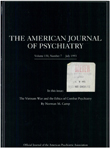Mood variability: a study of four groups
Abstract
OBJECTIVE: The authors' goal was to determine whether self-rated patterns of mood regulation differed among patients with major depression, patients with borderline personality disorder, patients with premenstrual syndrome (PMS), and normal subjects. METHOD: Fourteen days of morning and evening mood self-ratings on a visual analog scale were analyzed for 65 female subjects (10 with major depression, 16 with borderline personality disorder, 15 with PMS, and 24 without psychiatric diagnoses). For each individual, the mean and standard deviation of morning and evening ratings, the mean absolute change in mood from one day to the next, and the change from morning to evening were determined. RESULTS: The four groups differed significantly on every measure of mood and mood variability except diurnal variation. As expected, the group with major depression had the lowest global ratings and a low degree of variability. The group with borderline personality disorder was less depressed than the group with major depression and showed a high degree of mood variability. Autocorrelation analysis suggested that mood ratings in borderline personality disorder vary randomly from one day to the next. The mood variability over the 14 days of the patients with PMS was significantly greater than that of normal subjects. CONCLUSIONS: The visual analog scale can capture patterns of mood and mood variability thought to be typical of these diagnostic groups. Mood disorders differ not only in the degree of abnormal mood but also in the pattern of mood variability, suggesting that mechanisms regulating mood stability may differ from those regulating overall mood state.
Access content
To read the fulltext, please use one of the options below to sign in or purchase access.- Personal login
- Institutional Login
- Sign in via OpenAthens
- Register for access
-
Please login/register if you wish to pair your device and check access availability.
Not a subscriber?
PsychiatryOnline subscription options offer access to the DSM-5 library, books, journals, CME, and patient resources. This all-in-one virtual library provides psychiatrists and mental health professionals with key resources for diagnosis, treatment, research, and professional development.
Need more help? PsychiatryOnline Customer Service may be reached by emailing [email protected] or by calling 800-368-5777 (in the U.S.) or 703-907-7322 (outside the U.S.).



